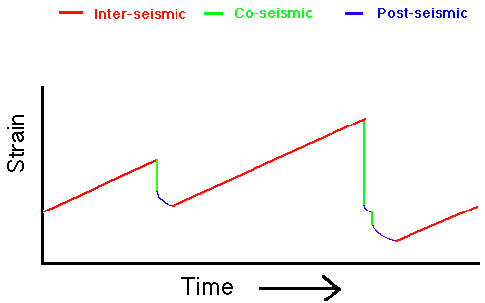Although not all earthquakes are caused by sudden slip along a fault, most of them are. The general concept you must keep in mind is that faults are relatively planar (flat) fractures in the crust along which rocks on either side of the fault move in different directions. Because fault surfaces are “rough”, rocks that meet along a fault do not slide freely past each other, but are instead locked for long periods by friction along the fault. Over decades to millenia, strain builds up within the rocks that are separated by the fault as their movement is prevented by along-fault friction. At some point, the amount of strain exceeds the frictional forces that are preventing slip. The fault ruptures and rocks on either side of the fault slide rapidly as the pent-up strain is relieved. The moment of rupture is when the earthquake occurs. For obvious reasons, the earthquake cycle is frequently referred to as a “stick-slip” process - long periods of “stick” are followed by a short period of “slip”, and the process then repeats itself.
The seismic “cycle” refers to the observation that earthquakes repeatedly rupture a given part of a fault. The term “cycle” does not however imply that earthquakes are a periodic or regularly repeating event (in other words, “cycle” does not imply that earthquakes are a natural phenomenon that have clocklike behavior like the rising and setting of the sun).
The seismic cycle can be divided into three periods, consisting of inter-seismic slip, co-seismic slip, and post-seismic slip. Two of these three phases are illustrated by the following figure, namely, the period of slow accumulation of elastic strain that coincides with frictional locking of a fault between earthquakes (the interseismic phase), and the sudden rupture that is the earthquake (the coseismic phase). The term “elastic” refers to a particular type of rock deformation, namely deformation that can be “recovered” at a future point. Elastic materials have “memory” of their original shape. If their shape is changed because a force is imposed on them, they will return to their original shape if the force is removed. A rubber band is an excellent example of an elastic material. So are rocks, provided that their temperatures aren’t too high.

Inter-seismic slip refers to the strain that accumulates steadily (the red lines above) between the earthquakes that irregularly but repeatedly rupture the fault. In general, measurements of the yearly motion of two sites that are located immediately across the fault from each other will show little or motion. Why? Because the fault is locked between earthquakes and crust adjacent to the fault thus cannot slip! In contrast, motion measured between two sites that are across the fault from one another, but are separated by distances of many tens of kilometers will show that the sites move significantly relative to each other. Why? Because far from the fault, crust must slip relative to crust across the fault or no strain would accumulate in the crust closer in to the fault.
Co-seismic slip refers to the slip that occurs at the instant of the earthquake (green lines above). Interestingly, measurements of co-seismic motion for site near and far from the fault show just the opposite pattern as exhibited for inter-seismic motion! Why? Because during an earthquake, the highly strained rocks near the fault rupture, which moved little or not at all during the inter-seismic period, are permitted to slide back to a less-strained state. In contrast, sites on crust far from the rupture zone were moving steadily during the inter-seismic period and thus accumulated little or no strain. During an earthquake, they thus move little or not at all as they slide into their “less-strained” state.
Post-seismic slip refers to slip that occurs in the days, months, and sometimes years after an earthquake (blue lines above). Such slip occurs for a variety of reasons and typically differs from the steady inter-seismic slip described above (although in some sense, post-seismic slip is simply a subset of inter-seismic slip). A fault that has experienced a significant rupture often continues to accommodate significant slip after the rupture. However, the post-seismic slip eventually decays back to the steady inter-seismic slip.